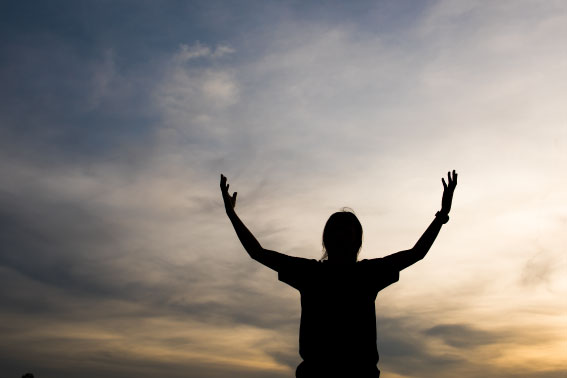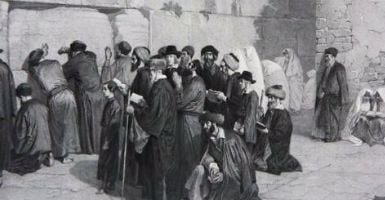Standing for Birchos Hamitzvah
One of the rules of Hilchos Brachos is that they should be recited while standing. The source for this rule is a Drasha cited by the Rishonim on the Pasuk instructing us in the Mitzva of Sefiras haOmer – “You shall count seven weeks – from when the sickle is first put to the standing crop, you shall begin to count seven weeks” (Devarim 16:9). Chaza”l reveal that the word “baKama” (“to the standing crop”) should be read as “b’Komah”, meaning “standing”.[1]
The Sefer haEshkol (23) states that this rule certainly only applies to Birchos haMitzvos, and not Birchos haNeheninrecited over Mitzvos – such as the Bracha on eating Matza, Kiddush, haMotzi (at a Shabbos or Yom Tov Seuda), or Birchas haMazon. He also outlines the Mitzvos to which this rule does apply and explains how Chaza”l extended this rule from Sefiras haOmer to other Mitzvos:
Our Rabbis stated: There are six Mitzvos whose Bracha is recited while standing: Sefiras haOmer, as the Pasuk states, “when the sickle is first put to the standing crop, you shall begin to count” – while standing. And since the Pasuk states, “and you shall count for yourselves” – “u’sefartem lachem”, we may extend [this rule to] other Mitzvos regarding which the Torah also employed the word “lachem”. [This is the case with regard to:] Kiddush Levana – (as the passuk states)
“Hachodesh haZeh Lachem”, Tzitzis – “V’Haya Lachem l’Tzitzis”, Shofar – “Yom Terua Yihyeh Lachem”, Lulav – “U’Lekachtem Lachem”, [and] Mila – “Himol Lachem”. The Yerushalmi also states: “All Brachos should be recited while standing – this was stated regarding Birchos haMitzvos, not Birchos haNehenin.”
According to the Eshkol, the obligation to stand only applies to six Birchos haMitzvos about which the Torah uses the word “Lachem”. The Machzor Vitri (376), Rokeach (Introduction to Hilchos Brachos), Kol Bo (22), and Tur (with regard to Tekias Shofar – O.C. 585) concur.
The Yereim (261) states: “I have heard this Drasha but I don’t know its source”. The Kol Bo and Orchos Chaim (Hilchos Tzitzis 27-28) claim that its source is the Talmud Yerushalmi, as does the Beis Yosef (O.C. 8). However, haGaon Rav Asher Weiss Shlit”a notes that this Drasha is not found in any extant version of the Yerushalmi, nor did the Kol Bo reveal where in the Yerushalmi it can be found. In fact, this is already noted by the Birkei Yosef (ibid.)
The Shiboley haLeket (Chag haSukkos 366) asserts that this Drasha can be found in the Medrash Lekach Tov. The Sefer haItur (Hilchos Tzitzis) similarly notes that its source is “Rabbenu Tuvya (Ben R’ Eliezer)” – the author of Midrash Lekach Tov. The Midrash Lekach Tov is also known as the “Pesikta Zutresa” and, indeed, this Drasha appears there in Parshas Emor.
R’ David Avudraham (15c) provides a mnemonic of the six Birchos haMitzvos which are recited while standing – “Olet”z Shale”m”. This stands for “Omer, Levana b’Chidusha (the new moon), Tzitzis, Shofar, Lulav, and Mila. He then concludes:
There are Mitzvos where it is a Mitzva min haMuvchar to recite the Bracha while standing. However, if one does not do so, one need not be concerned. Examples are; Hallel, reading the Megila, and Sukkah. Some say that the rule is that one recites the Bracha for any Mitzva that does not entail Hana’ah while standing.
The Avudraham implies that standing for the six Birchos haMitzvos which are derived from Sefiras haOmer, is l’Ikuva (required in order to fulfill one’s obligation). The Yechaveh Da’as (5:4) relates that this is also the Radvaz’s understanding of the Avudraham. However, it is more reasonable that the Avudraham does not argue with the other Rishonim who imply that standing for Birchas haMitzvos is not l’Ikuva. The distinction that he draws between the six Birchos haMitzvos that are derived from Sefiras haOmer and other Mitzvos, may be understood differently. The obligation to stand for the six Birchos haMitzvos is an enactment of the Chachamim – a person who does not comply has defied that enactment. The obligation to stand for other Birchos haMitzvos is only a “Mitzva min haMuvchar” – one who fails to do so has not defied an actual enactment. In either case, standing is not l’Ikuva.
The sources quoted thus far indicate that there is only an obligation to stand for the Brachos on the six Mitzvos that are derived from Sefiras haOmer. However, the Yerushalmi cited by the Eshkol implies that this obligation applies to all Birchos haMitzvos.
The Pnei Yehoshua (Megila 21a) contends that the obligation to stand for Birchos haMitzvos only applies to those Mitzvos which are performed while standing, such as Tzitzis and Shofar. There is no obligation to stand when the Mitzva is performed while sitting, such as Krias haMegila.
He adduces proof for this from the Mitzva of Challah. The Mishna (Challah 2:2) states: “A woman sits and separates her Challah” – in other words, she is permitted to sit while reciting the Bracha. The Magen Avraham asks why this is the case – surely a person is obligated to stand for Birchos haMitzvos. The Mor u’Ketzia (8) answers that since the Mitzva of separating Challah can be performed while sitting, there is no obligation to stand while reciting the Bracha on the Mitzva. This is also the conclusion of other Poskim.
It seems that the Pnei Yehoshua’s position is predicated on the understanding that the obligation to stand while reciting Birchos haMitzvos is not a condition of Hilchos Brachos but an act of showing honor to the Mitzvos. This is why it does not apply to Birchos heNehenin. If the Mitzva itself is performed while standing, it is only proper to recite its Bracha while standing. However, if the Mitzva may be performed while sitting, there is no obligation to show honor to the Mitzva by standing during the Bracha.
The Acharonim discuss whether one is obligated to stand to recite Birchos haTorah. Two arguments are made to permit one to sit:
Some say that since the Shulchan Aruch rules (Y.D. 246:9) that a person is not obligated to stand while learning Torah, he is similarly not obligated to stand during the Brachos – as per the Pnei Yehoshua. (However, we should note that the Magen Avraham and Pri Megadim (O.C. 8) appear to disagree with the Pnei Yehoshua.)
The Rama m’Pano (102) makes a different argument:
Regarding Birchos haTorah for an individual – which we are not careful to recite while standing – it is different as it is common. It also states [with regard to Torah study] “when you sit in your house”. This reason also applies to Birchos Krias Shema.
The Pri Megadim (O.C. 8, Eshel Avraham 2) issues a particularly novel ruling with regard to Birchos Krias Shema. He rules that a person is not obligated to stand for Birchos Krias Shema because they require Kavana, and a person can concentrate better when he is sitting.
This is an extremely important principle. Though the Pri Megadim only discusses Birchos Krias Shema, his reasoning can similarly be applied to other Birchos haMitzvos where greater Kavana would be possible if the person were sitting.
Though certain Rishonim – particularly the Avudraham – imply that the obligation of standing for Birchos haMitzvos is l’Ikuva, the Halacha is that if a person fails to do so he fulfills his obligation Bedieved. This is because the Drasha is only an Asmachta (not a full-fledged exposition). In fact, according to the Rambam (Hilchos Temidin u’Musafin 7:23), even with regard to Sefiras haOmer a person fulfills his obligation Bedieved.[2] The Shulchan Aruch (O.C. 489:1), notably does not include an explicit clause stating that a person fulfills his obligation Bedieved if he doesn’t stand. However, given that he merely states, “One needs to count while standing”, the implication is that this condition is not l’Ikuva. This is also the conclusion of the Magen Avraham (ibid. 3) and other Acharonim (ibid.).
The same is true of Tekias Shofar. The Shulchan Aruch (O.C. 585:1) states merely, “One needs to sound the Shofar while standing”, but the Magen Avraham (ibid. 1) adds that if a person did so while sitting, he fulfills his obligation. This is because the obligation to stand is derived from Sefiras haOmer, where he similarly fulfills his obligation if he sits during the Bracha.
The Rishonim imply that the aforementioned Drasha is a bona fide Biblical exposition. However, as stated, it is almost certainly a d’Rabbanan or a Minhag. HaGaon Rav Asher Weiss Shlit”a proves this from the text of the Pesikta itself, which includes Kiddush Levana as one of the six Birchos haMitzvos for which one has to stand. Given that Kiddush Levana is itself a Mitzva d’Rabbanan, the Pesikta cannot possibly mean that the obligation to stand is a Mitzva d’Oraisa.
The Poskim rule that if a Mitzva is meant to be performed while standing, a healthy person may not even lean slightly to support himself. An overweight or sick person for whom standing is difficult, may support himself slightly. However, he may not support himself to the degree that he would fall if the support would be removed. These conditions are cited by the aforementioned Magen Avraham with regard to Shofar. Nevertheless, the Mishna Berura (ibid. 2, Sha’ar haTziyun 2) maintains that, in a pressing situation, a person may rely on the opinion of the Birkei Yosef who permits a person to support himself because the Drasha obligating us to stand is only an Asmachta, as stated. The Piskei Teshuvos (O.C. 489:4) cites several Acharonim who rule similarly.
Therefore, a sick person who has difficulty standing during a Bracha for a Mitzva may sit. He certainly should not desist from a Mitzva d’Oraisa on account of a Rabbinic condition regarding the Bracha. Moreover, according to the aforementioned Pri Megadim, if standing would interrupt a person’s Kavana he may sit. Although Birchos haMitzvos are generally short, those who are sick or disabled may find it difficult to stand even for a short time and their Kavana would be disturbed.
Regarding Shemona Esrei the Shulchan Aruch rules (O.C. 94:6): “A sick person should Daven, even lying on his side, so long as he is able to concentrate”. The Mishna Berura (ibid. 20) adds that the same applies to an elderly person. However, if he expects that he would be able to stand with support, he should not sit (ibid. 24). The Poskim also say that if he is able to stand at least for the Bracha of Avos, he should do so (see Shevet haLevi, 10:19). The same applies to the sections of the Shemona Esrei in which one bows and the concluding passage at which one steps back afterward.
When reciting Shemona Esrei in a sitting position a person should position his feet next to one another, which is a sign of fear and awe (see the Mishna Berura, 95:2). This applies not only to the sick and disabled but also to those Davening on a plane or bus in a sitting position.
We will conclude by raising a question with regard to Bris Mila, which, as we have noted, is one of the six Mitzvos for which one must stand.
At a Bris, the Mohel recites the Bracha “Al haMila”. The second Bracha – “l’Hachniso biVriso Shel Avraham Avinu” – should be recited by the father, as stated by the Shulchan Aruch (Y.D. 265:1). However, the Rema cites a custom that the Sandek recites the Bracha.
The Rema continues: “The father and the Mohel – when they recite the Bracha, they should stand. But the person who holds the child – when he recites the blessing – the custom is that he should recite it while sitting.”
The Acharonim discuss whether it is correct for a Sandek to also serve as Mohel. The Pri Megadim (O.C. 585, Mishbetzos Zahav 10) argues that it is not appropriate because he will be unable to stand for the Bracha of “Al haMila”. Others point out that the Bris itself should be performed in a standing position.
However, the Sefer Kores haBris (265:11) contends that one need only stand to perform the Bris if sitting would not fulfill a Mitzva. In the case of a Sandek, where his Mitzva is fulfilled by sitting, there is no reason why he would have to perform the Bris while standing.
According to this reasoning, the Pri Megadim’s Chidush will depend upon the Machlokes haPoskim cited above. According to the Pnei Yehoshua, where there is no obligation to stand for a Mitzva, there is similarly no obligation to stand for its Bracha. In this case, if the Sandek is not obligated to stand for the Bris (as he fulfills a Mitzva by sitting), he would similarly have no obligation to stand for the Bracha.
Regardless, a Sandek could theoretically stand while reciting the Bracha and then sit down to perform the Bris. However, this may not be a good solution. HaGaon Rav Asher Weiss Shlit”a suggests that the reason for the obligation to stand while reciting Birchas haMitzvos may be due to a concern that one will make a Hefsek between the Bracha and the Mitzva, and the Bracha will not be “Over la’Asiyaso”. He explains:
Though, clearly,
standing and sitting do not constitute an actual Hefsek, nevertheless, we see
in many sources that the Chachamim endeavored to ensure that the Bracha and the
item or act upon which one is reciting the Bracha should be as close to one
another as possible. That is why they said that a person should cut into the
bread before he recites the Bracha and take the Lulav in hand before reciting
the Bracha. There are many other examples. Therefore, it is better to recite
the Bracha in the position in which one will fulfill the Mitzva – either
standing or sitting.”
[1] See the Rosh, end of Pesachim and other Rishonim.
[2] The Kesef Mishna (ibid.) cites the aforementioned Drasha as well as the comments of the Zohar which explain the deeper reason why, Lechatchila, a person should stand for the Bracha on Sefiras haOmer. The days of Sefiras haOmer, according to the Zohar, represent the “Zachar” (male) nature. Therefore, one should stand – in a position of strength, like a male – rather than sit which would represent the female nature.














